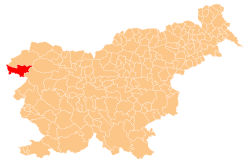Municipality of Kobarid
|
Municipality of Kobarid Občina Kobarid |
|
|---|---|
| Municipality | |
 Location of the Municipality of Kobarid in Slovenia |
|
| Coordinates: 46°14′47″N 13°34′43″E / 46.24639°N 13.57861°ECoordinates: 46°14′47″N 13°34′43″E / 46.24639°N 13.57861°E | |
| Country |
|
| Government | |
| • Mayor | Darja Hauptman (SDS) |
| Area | |
| • Total | 192.7 km2 (74.4 sq mi) |
| Population (2010) | |
| • Total | 4,217 |
| • Density | 22/km2 (57/sq mi) |
| Time zone | CET (UTC+01) |
| • Summer (DST) | CEST (UTC+02) |
The Municipality of Kobarid (pronounced [kɔbaˈɾiːt]; Slovene: Občina Kobarid) is a municipality in the Upper Soča Valley in western Slovenia, near the Italian border. The seat of the municipality is the town of Kobarid. The municipality was established on 3 October 1994, when the former larger Municipality of Tolmin was subdivided into the municipalities of Bovec, Kobarid, and Tolmin.
The area has been inhabited since prehistoric times. Archeological remains from the Hallstatt period have been found in the area. In the 6th century, it was settled by Slavic tribes, ancestors of the modern Slovenes. During the Middle Ages, it was first part of the Patriarchate of Aquileia, and later of Tolmin County, before being included in the Habsburg Monarchy in the 15th century, like the majority of Slovene-speaking territories. With the exception of a brief period between 1809 and 1813, when it was included under the Napoleonic Kingdom of Italy, it remained under the Austrian rule until 1918.
In the mid-19th century, the area became an important center of the Slovene national revival. During World War I, the whole area was the theatre of the Battles of the Isonzo, fought between Italy and Austria-Hungary. After the end of the war in 1918, the region was occupied by the Italian Army, and in 1920 it was officially annexed to Italy, and included in the Julian March region. Between 1922 and 1943, the Kobarid area, which had an exclusively Slovene-speaking population, was submitted to a policy of violent Fascist Italianization. Many locals emigrated to the neighbouring Kingdom of Yugoslavia. Several Italian military memorials were built in the area.
...
Wikipedia
